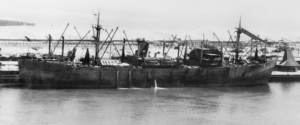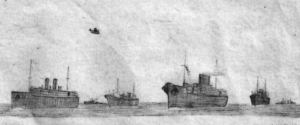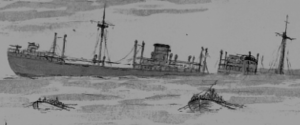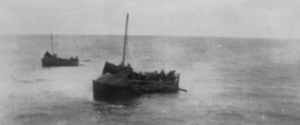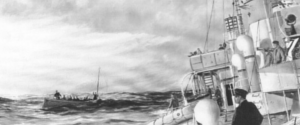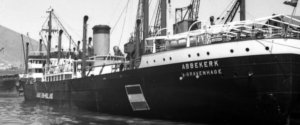HMS Wallflower rejoins the convoy

30 August 1942.
Survivors, almost certainly from Abbekerk, on board HMS Wallflower. The man in a white overall reading a newspaper could very wel be engineer Adriaan Kik (Thanks to Roy Terry)
First of all the cook had quickly made a soup. This soup was the tastiest food I have ever eaten. Not a surprise really. We were accommodated in a couple of mess-rooms. I can remember that walking was a bit difficult and sitting down even on a soft cushion was painful on our bottoms. The officers and crew were very helpful and it seemed they were even more pleased about our rescue than we were.
A few hours later the alarm sounded and with much ringing of bells the watertight doors were shut. We were below decks and in case of an emergency totally trapped. I looked around and came to the conclusion that the skin of the ship was terribly thin. I decided there and then that if this was a false alarm and the doors would be opened, I would in any case go out on deck and not return down below. However it never got that far, for as soon as this corvette had returned to the convoy we were distributed over the ships.
Assistent engineer Adriaan Kik
The survivors are redistributed over different convoy ships, depending on available space on board, the service the men are in and – if possible – the nationality.
- 18 to Jan van Gooyen (Dutch)
- 4 to Janeta (British)
- 5 to Saturnus (Dutch)
- 4 to Gragpool (British)
- 12 to Pan New York (US)
- 4 to Widestone (British)
- 7 to HMS Watchman (British destroyer)
- 7 to HMS Hurricane (British destroyer)

HMS Wallflower in Albert Dock June 1942. Note the radar dome in front of the mast and the small size of the vessel. (Source: IWM.com)
The English servicemen, including gunner Walter MacNab, end up on the destroyers HMS Watchman and HMS Hurricane. During the transfer the ships did not stop, that would have made them too easy a target for the submarines which could have been lurking around. Walter recalls the transfer vividly:
We took our places in the lifeboat on the corvette; it was then swung out on its davits and the engine started (it was of course a power operated lifeboat). The corvette reduced speed and as it rolled in the heavy sea the crew waited until the lifeboat was just above the top of swell at the bottom of the ships roll and just prior to it rolling back, at which time they simultaneously snatched the fore and aft release blocks in the davits and the lifeboat dropped into the water Immediate it was given full throttle and shot away from the corvette. The timing had to be perfect. [..]
The next part of the exercise was getting from the lifeboat to the destroyer. This was just as thrilling. We drew as close as possible alongside the destroyer. Ropes were dropped to the lifeboat attached to davits on the destroyer and again at an opportune moment when the destroyer rolled over the lifeboat we were whipped like lightning out of th water and swinging safely on the destroyer davits. I wondered how this could happen so quickly until I saw it being done again. Because the ship was moving fairly fast this exercise had to be done at express speed. The ships winch was much too slow for the job so the captain turned out most of the crew on deck and they acted as the winch. The rope normally attached to the winch was held by the crew and at the captain’s signal they ran the length of tt deck pulling on the rope. Believe me, we came out of the water like an express train. Manpower on this occasion was much more efficient than steam or electricity.
Gunner Walter MacNab

